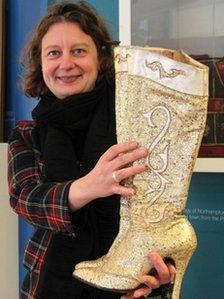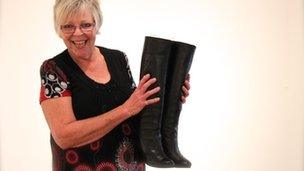Wanted: Old shoes with soul, for new life in museum
- Published

Roger Fearnside gifted seven pairs of immaculate crocodile skin shoes
A museum which claims to have one of the largest collections of footwear in the world is on the hunt for the stories behind people's favourite shoes.
With a vast shoe rack of 12,000 pairs, The Shoe Collection at Northampton Museums and Art Gallery, may seem to have enough footwear for anyone's tastes but the museum claims it still needs more pairs to fill gaps in shoe design and social history in its collection.
The "We Want your Shoes!" appeal is requesting footwear donations from members of the public.
"It's become a bit like Christmas when the donations arrive," says councillor Anna King in the museum's archive.
"We're never quite sure what fascinating story we're going to unwrap next."
'Beyond bling'
It seemed several Christmases had arrived at once when the museum received a parcel from Dr Naomi Braithwaite, senior lecturer in Fashion Communication at Manchester Metropolitan University.

Dr Naomi Braithwaite said she was not sad to see her boots go
Inside was a pair of 1970s gold sparkly knee high boots created by legendary shoe designer Terry de Havilland, also known as the "rock and roll cobbler".
'They're beyond bling aren't they," says Dr Braithwaite holding her boots up so their holographic gold scales turn light into rainbows.
"I bought them on eBay, and looking at the angle of the heels, I'd say they've seen some serious nightclub action with their previous owner 40 years ago."
There is a very personal connection to these boots.
"I met and interviewed Terry de Havilland several times for my PhD and the design of these boots is very much inspired by what he called 'the roller-coaster of craziness' that was his life in the 1970s," says Dr Braithwaite.
The academic said she had never worn the treasured vintage boots out to a party.
"They were too fragile, so I wore them around the house and when I suffered writer's block I wore them at my desk for inspiration."
And she said she was not sad to part with them.
"They have a tale to tell beyond their owner's. The designer's own story is embedded in them and here at the museum that will come to life."
For others, parting with footwear is an emotional moment.
It was with tears in her eyes that Diane Clark from Northamptonshire handed over her cherished pair of black boots made by The Chelsea Cobbler and bought from Russell & Bromley in 1973.
She said: "I clearly remember the day I saw them and thought: I don't just want those boots, I'm going to have them. I paid the princely sum of £32 and when my husband asked me how much they cost, I lied and said they were £24."
For the museum, Ms Clark's boots are a rare original by The Chelsea Cobbler officials are keen to display.
For Ms Clark, though, they embody a care-free hedonistic period of young married life.
'Looked after forever'
"It was very much, 'if you've got it flaunt it'," she said.
"But in 1980 everything changed. We adopted a little boy and I packed those boots away as I couldn't run around in high heels anymore."
She then kept them at the back of her wardrobe for decades.
"I simply couldn't bear the idea of one day my house being cleared and my boots going to a charity shop. Here at the museum I know they will be looked after for ever."
Other donations to the museum have come from families relieved there is now an alternative to charity shops for special shoes belonging to deceased relatives.

Diane Clark's boots reminded her of a care-free period in her life
Roger Fearnside handed over seven pairs of immaculate crocodile skin shoes that had been handmade in Singapore for his mother in 1951 when the family was posted there with the RAF.
They will be displayed along with Mr Fearnside's family photos showing his mother wearing the shoes to parties.
One of the most poignant gifts was a box containing two pairs of snakeskin shoes from the 1950s belonging to a Major L.F.E James who died seven years ago.
They came with a note from his wife which read: "I had a little weep for the wonderful man who wore these shoes. Now I hope you will find a place for them."
The story behind the museum's shoes, which is part of a series of three reports about shoes, will be on Radio 4's Woman's Hour from 10:00 GMT on Wednesday 4 December 2013 and afterwards on iPlayer Radio.
- Published18 June 2013
- Published14 April 2012